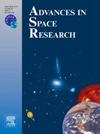Mechanism and characteristics analysis of weak stability boundary transfers to the 2:1 distant retrograde orbit
IF 2.8
3区 地球科学
Q2 ASTRONOMY & ASTROPHYSICS
引用次数: 0
Abstract
The 2:1 resonant distant retrograde orbit (DRO) has garnered considerable attention in contemporary cislunar space missions due to its strategic importance. This study conducts a thorough analysis of the mechanisms and characteristics governing global bi-impulse Earth-DRO transfer trajectories via the weak stability boundary (WSB) in the planar bicircular restricted four-body problem. Initially, a substantial number of feasible low-energy solutions are obtained through a grid search coupled with the multiple shooting differential correction algorithm, revealing previously undiscovered trajectories. Subsequently, the global picture and Pareto front solutions are presented. The departure conditions for the global solutions are discussed separately from the perspectives of the Earth-Moon rotating frame and the Sun- rotating frame, along with their respective characteristics. For transfers involving a translunar phase, we analyze the distribution characteristics of relevant parameters on the perilune Poincaré section, revealing intrinsic features of the translunar trajectories. In order to deepen the understanding of the WSB transfer process, this study further explores the effect of solar perturbation along the trajectories, elucidating several mechanisms of low-energy transfer. Finally, a comprehensive analysis and summary of DRO capture trajectories are provided.
求助全文
约1分钟内获得全文
求助全文
来源期刊

Advances in Space Research
地学天文-地球科学综合
CiteScore
5.20
自引率
11.50%
发文量
800
审稿时长
5.8 months
期刊介绍:
The COSPAR publication Advances in Space Research (ASR) is an open journal covering all areas of space research including: space studies of the Earth''s surface, meteorology, climate, the Earth-Moon system, planets and small bodies of the solar system, upper atmospheres, ionospheres and magnetospheres of the Earth and planets including reference atmospheres, space plasmas in the solar system, astrophysics from space, materials sciences in space, fundamental physics in space, space debris, space weather, Earth observations of space phenomena, etc.
NB: Please note that manuscripts related to life sciences as related to space are no more accepted for submission to Advances in Space Research. Such manuscripts should now be submitted to the new COSPAR Journal Life Sciences in Space Research (LSSR).
All submissions are reviewed by two scientists in the field. COSPAR is an interdisciplinary scientific organization concerned with the progress of space research on an international scale. Operating under the rules of ICSU, COSPAR ignores political considerations and considers all questions solely from the scientific viewpoint.
 求助内容:
求助内容: 应助结果提醒方式:
应助结果提醒方式:


